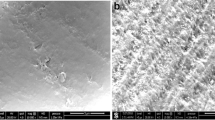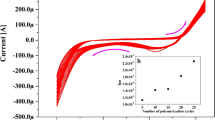Abstract
An activated carbon was prepared using physical activation from date stone. This activated carbon was characterized by SEM, XRD, and FT-IR. This composite was used as modifier of carbon paste electrode (AC/CPE) for electrochemical determination of catechol (CC) and hydroquinone (HQ) using cyclic voltammetry. The electrochemical experiments indicated that the modified electrodes can simultaneously determinate HQ and CC at an oxidative and reductive peaks separation of about 125 and 120 mV, respectively. Furthermore, differential pulse voltammetry (DPV) of the sensing platform showed wide linear responses in the presence of 5.0 × 10−5 mol L−1 CC with the limit of detection (S/N = 3) of 7.1 × 10−8 mol L−1. At the same time, the oxidation peak current of CC was linear to its concentration with the limit of detection (S/N = 3) of 5.23 × 10−8 mol L−1 in the presence of 1.0 × 10−4 mol L−1 HQ.









Similar content being viewed by others
References
Du H, Ye J, Zhang J, Huang X, Yu C (2011) A voltammetric sensor based on graphene-modified electrode for simultaneous determination of catechol and hydroquinone. J Electroanal Chem 650:209–213
Blaut M, Braune A, Wunderlich S, Sauer P, Schneider H, Glatt H (2006) Mutagenicity of arbutin in mammalian cells after activation by human intestinal bacteria. Food Chem Toxicol 44:1940–1947
Yin H, Zhang Q, Zhou Y, Ma Q, liu T, Zhu L, Ai S (2011) Electrochemical behavior of catechol, resorcinol and hydroquinone at graphene–chitosan composite film modified glassy carbon electrode and their simultaneous determination in water samples. Electrochim Acta 56:2748–2753
Khodaei MM, Alizadeh A, Pakravan N (2008) Polyfunctional tetrazolic thioethers through electro-oxidative/Michael-type sequential reactions of 1,2- and 1,4- dihydroxybenzenes with 1-phenyl-5-mercaptotetrazole. J Org Chem 73:2527–2532
Jagetia GC, Aruna R (1997) Hydroquinone increases the frequency of micronuclei in a dose-dependent manner in mouse bone marrow. Toxicol Lett 93:205–213
Taysse L, Troutaud D, Khan NA, Deschaux P (1995) Structure-activity relationship of phenolic compounds (phenol, pyrocatechol and hydroquinone) on natural lymphocytotoxicity of carp (Cyprinus carpio). Toxicology 98:207–214
Hirakawa K, Oikawa S, Hiraku Y, Hirosawa I, Kawanishi S (2002) Catechol and hydroquinone have different redox properties responsible for their differential DNA-damaging ability. Chem Res Toxicol 15:76–82
Yuan X, Yuan D, Zeng F, Zou W, Tzorbatzogloub F, Tsiakaras P, Wang Y (2013) Preparation of graphitic mesoporous carbon for the simultaneous detection of hydroquinone and catechol. Appl Catal B Environ 129:367–374
Ahammad AJS, Sarker S, Rahman MA, Lee JJ (2010) Simultaneous determination of hydroquinone and catechol at an activated glassy carbon electrode. Electroanalysis 22:694–700
Asan A, Isildak I (2003) Determination of major phenolic compounds in water by reversed-phase liquid chromatography after pre-column derivatization with benzoyl chloride. J Chromatogr A 988:145–149
Li SF, Li XZ, Xu J, Wei XW (2008) Flow-injection chemiluminescence determination of polyphenols using luminol–NaIO4–gold nanoparticles system. Talanta 75:32–37
Cui H, Zhang QL, Myint A, Ge XW, Liu LJ (2006) Chemiluminescence of cerium(IV)–rhodamine 6G–phenolic compound system. J Photochem Photobiol A Chem 181:238–245
Nagaraja P, Vasantha RA, Sunitha KR (2001) A sensitive and selective spectrophotometric estimation of catechol derivatives in pharmaceutical preparations. Talanta 55:1039–1046
Unnikrishnan B, Ru PL, Chen SM (2012) Electrochemically synthesized Pt–MnO2 composite particles for simultaneous determination of catechol and hydroquinone. Sensors Actuators B Chem 169:235–242
Li DW, Li YT, Song W, Long YT (2010) Simultaneous determination of dihydroxybenzene isomers using disposable screen-printed electrode modified by multiwalled carbon nanotubes and gold nanoparticles. Anal Methods 2:837–843
Zhang X, Duan S, Xu XM, Xu S, Zhou CL (2011) Electrochemical behavior and simultaneous determination of dihydroxybenzene isomers at a functionalized SBA-15 mesoporous silica modified carbon paste electrode. Electrochim Acta 56:1981–1987
Shaikh AA, Saha SK, Bakshi PK, Hussain A, Ahammad AJS (2013) Poly(brilliant cresyl blue)-modified electrode for highly sensitive and simultaneous determination of hydroquinone and catechol. J Electrochem Soc 160:37–42
Ahammad AJS, Rahman MM, Xu GR, Kim S, Lee JJ (2011) Highly sensitive and simultaneous determination of hydroquinone and catechol at poly(thionine) modified glassy carbon electrode. Electrochim Acta 56:5266–5271
Vilian ATE, Chen SM, Huang LH, Ali MA, Al-Hemaid FMA (2014) Simultaneous determination of catechol and hydroquinone using a Pt/ZrO2-RGO/GCE composite modified glassy carbon electrode. Electrochim Acta 125:503–509
Guo HL, Peng S, Xu JH, Zhao YQ, Kang XF (2014) Highly stable pyridinic nitrogen doped graphene modified electrode in simultaneous determination of hydroquinone and catechol. Sensors Actuators B Chem 193:623–629
Yue XY, Pang SP, Han PX, Zhang CJ, Wang JL, Zhang LX (2013) Carbon nanotubes/carbon paper composite electrode for sensitive detection of catechol in the presence of hydroquinone. Electrochem Commun 34:356–359
Kumar A, Jena HM (2016) Preparation and characterization of high surface area activated carbon. Results Phys 6:651–658
Bachrun S, AyuRizka N, Annisa SH, Arif H (2016) Preparation and characterization of activated carbon from sugarcane bagasse by physical activation with CO2 gas. IOP Conf Ser Mater Sci Eng 105:12–27
Jain A, Xu C, Jayaraman S, Balasubramanian R, Lee JY, Srinivasan MP (2015) Mesoporous activated carbons with enhanced porosity by optimal hydrothermal pre-treatment of biomass for supercapacitor applications. Microporous Mesoporous Mater 218:55–61
Ghasemi M, Mashhadi S, Asif M, Tyagi I, Agarwal S, Gupta VK (2016) Microwave- assisted synthesis of tetraethylenepentamine functionalized activated carbon with high adsorption capacity for Malachite green dye. J Mol Liq 213:317–325
Saeidi N, Parvini M, Niavarani Z (2015) High surface area and mesoporous graphene/activated carbon composite for adsorption of Pb(II) from wastewater. J Environ Chem Eng 3:2697–2706
Zhu Z, Li A, Xia M, Wan J, Zhang Q (2008) Preparation and characterization of polymer based spherical activated carbons. Chin J Polym Sci 26:645–651
Park JH, Park OO, Shin KH, Jin CS, Kim JH (2002) An electrochemical capacitor based on a Ni (OH) 2/activated carbon composite electrode. Electrochem Solid State Lett 5:7–10
Stavropoulos GG, Zabaniotou AA (2009) Minimizing activated carbons production cost. Fuel Process Technol 90:952–957
Muniandy L, Adam F, Mohamed AR, Ng EP (2014) The synthesis and characterization of high purity mixed microporous/mesoporous activated carbon from rice husk using chemical activation with NaOH and KOH. Microporous Mesoporous Mater 197:316–323
Malik R, Ramteke DS, Wate SR (2006) Physico-chemical and surface characterization of adsorbent prepared from groundnut shell by ZnCl2 activation and its ability to adsorb colour. Indian J Chem Technol 13:319–328
Gratuito MKB, Panyathanmaporn T, Chumnanklang RA, Sirinuntawittaya N, Dutt A (2008) Production of activated carbon from coconut shell: optimization using response surface methodology. Bioresour Technol 99:4887–4895
Hussaro K (2014) Preparation of activated carbon from palm oil shell by chemical activation with Na2CO3 and ZnCl2 as imprenated agents for H2S adsorption. Am J Environ Sci 10:336–346
Hammani H, Boumya W, Laghrib F, Farahi A, Lahrich S, Aboulkas A, El Mhammedi MA (2017) Electro-catalytic effect of Al2O3 supported onto activated carbon in oxidizing phenol at graphite electrode. Mater Today Chem 3:27–36
Hammani H, Boumya W, Laghrib F, Farahi A, Lahrich S, Aboulkas A, El Mhammedi MA (2017) Electrocatalytic effect of NiO supported onto activated carbon in oxidizing phenol at graphite electrode: application in tap water and olive oil samples. J Assoc Arab Univ Basic Appl Sci 24:26–33
Kumar K, Saxena RK, Kothari R, Suri DK, Kaushik NK, Bohra JN (1997) Correlation between adsorption and x-ray diffraction studies on viscose rayon based activated carbon cloth. Carbon 35:1842–1844
Deraman M, Talib IA, Omar RM, Jumali HHJ, Taer E, Saman MM (2010) Microcrystallite dimension and total active surface area of carbon electrode from mixtures of PreCarbonized oil palm empty fruit bunches and green petroleum cokes. Sains Malaysiana 39:83–86
Yang T, Lua A (2003) Characteristics of activated carbons prepared from pistachio-nut shells by physical activation. J Colloid Interface Sci 267:408–417
Kuskur CM, Swamy BEK, Jayadevappa H (2017) Poly (naphthol green B) modified carbon paste electrode sensor for catechol and hydroquinone. J Anal Chem 804:99–106
Ganesh PS, Swamy BEK (2016) Voltammetric resolution of catechol and hydroquinone at eosin Y film modified carbon paste electrode. J Mol Liq 220:208–215
Naik TSSK, Swamy BEK (2017) Modification of carbon paste electrode by electrochemical polymerization of neutral red and its catalytic capability towards the simultaneous determination of catechol and hydroquinone: a voltammetric study. J Anal Chem 804:78–86
Yin H, Ma Q, Zhou Y, Ai S, Zhu L (2010) Electrochemical behavior and voltammetric determination of 4-aminophenol based on graphene–chitosan composite film modified glassy carbon electrode. Electrochim Acta 55:7102–7108
Liu Z, Wang Z, Cao Y, Jing Y, Liu Y (2011) High sensitive simultaneous determination of hydroquinone and catechol based on graphene/BMIMPF 6 nanocomposite modified electrode. Sensors Actuators B Chem 157:540–546
Song D, Xia J, Zhang F, Bi S, Xiang W, Wang Z, Xia L, Xia Y, Li Y, Xia L (2015) Multiwall carbon nanotubes-poly(diallyldimethylammonium chloride)-graphene hybrid composite film for simultaneous determination of catechol and hydroquinone. Sensors Actuators B Chem 206:111–118
Gan T, Sun J, Huang K, Song L, Li Y (2013) A graphene oxide–mesoporous MnO2 nanocomposite modified glassy carbon electrode as a novel and efficient voltammetric sensor for simultaneous determination of hydroquinone and catechol. Sensors Actuators B Chem 177:412–418
Kumar M, Swamy BEK, Chandra U, Gebisa AW (2017) Co3O4/CuO composite nanopowder/sodium dodecyl sulphate modified carbon paste electrode based voltammetric sensors for detection of dopamine. Int J Nanotechnol 14:930–944
Mohan K, Swamy BEK, Asif MHM, Viswanath CC (2017) Preparation of alanine and tyrosine functionalized graphene oxide nanoflakes and their modified carbon paste electrodes for the determination of dopamine. Appl Surf Sci 399:411–419
Si WM, Lei W, Zhang YH, Xia MZ, Wang FY, Hao QL (2012) Electrodeposition of graphene oxide doped poly (3,4-ethylenedioxythiophene) film and its electrochemical sensing of catechol and hydroquinone. Electrochim Acta 85:295–301
Shankar SS, Swamy BEK, Pandurangachar M, Chandra U, Chandrashekar BN, Manjunatha JG, Sherigara BS (2010) Electrocatalytic oxidation of dopamine on acrylamide modified carbon paste electrode: a voltammetric study. Int J Electrochem Sci 5:944–954
Chandra U, Swamy BEK, Mahanthesha KR, Vishwanath CC, Sherigara BS (2013) Poly (malachite green) film based carbon paste electrode sensor for the voltammetric investigation of dopamine. Chem Senses 3:1–6
Zheng LZ, Xiong LY, Li YD, Xu JP, Kang XW, Zou ZJ, Yang SM, Xia J (2013) Facile preparation of polydopamine-reduced graphene oxide nanocomposite and its electrochemical application in simultaneous determination of hydroquinone and catechol. Sensors Actuators B Chem 177:344–349
Wang LP, Meng Y, Chen Q, Deng JH, Zhang YY, Li HT, Yao SZ (2013) Simultaneous electrochemical determination of dihydroxybenzene isomers based on the hydrophilic carbon nanoparticles and ferrocene-derivative mediator dual sensitized graphene composite. Electrochim Acta 92:216–225
Wang L, Bai J, Wang H, Zhang L, Zhao Y (2007) Direct simultaneous electrochemical determination of hydroquinone and catechol at a poly(glutamic acid) modified glassy carbon electrode. Int J Electrochem Sci 2:123–132
Acknowledgements
The research described in this article has been funded wholly by the university Hassan 1, Morocco.
Author information
Authors and Affiliations
Corresponding author
Rights and permissions
About this article
Cite this article
Hammani, H., Laghrib, F., Lahrich, S. et al. Effect of activated carbon in distinguishing the electrochemical activity of hydroquinone and catechol at carbon paste electrode. Ionics 25, 2285–2295 (2019). https://doi.org/10.1007/s11581-018-2648-6
Received:
Revised:
Accepted:
Published:
Issue Date:
DOI: https://doi.org/10.1007/s11581-018-2648-6




